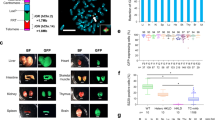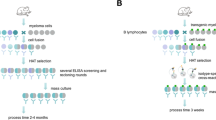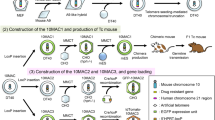Abstract
Human polyclonal antibodies (hPABs) are useful therapeutics, but because they are available only from human donors, their supply and application is limited. To address this need, we prepared a human artificial chromosome (HAC) vector containing the entire unrearranged sequences of the human immunoglobulin (hIg) heavy-chain (H) and lambda (λ) light-chain loci. The HAC vector was introduced into bovine primary fetal fibroblasts using a microcell-mediated chromosome transfer (MMCT) approach. Primary selection was carried out, and the cells were used to produce cloned bovine fetuses. Secondary selection was done on the regenerated fetal cell lines, which were then used to produce four healthy transchromosomic (Tc) calves. The HAC was retained at a high rate (78–100% of cells) in calves and the hIg loci underwent rearrangement and expressed diversified transcripts. Human immunoglobulin proteins were detected in the blood of newborn calves. The production of Tc calves is an important step in the development of a system for producing therapeutic hPABs.
This is a preview of subscription content, access via your institution
Access options
Subscribe to this journal
Receive 12 print issues and online access
$209.00 per year
only $17.42 per issue
Buy this article
- Purchase on Springer Link
- Instant access to full article PDF
Prices may be subject to local taxes which are calculated during checkout




Similar content being viewed by others
References
Tomizuka, K. et al. Double trans-chromosomic mice: maintenance of two individual human chromosome fragments containing Ig heavy and kappa loci and expression of fully human antibodies. Proc. Natl. Acad. Sci. USA 97, 722–727 (2000).
Bruggemann, M. et al. Human antibody production in transgenic mice: expression from 100 kb of the human IgH locus. Eur. J. Immunol. 21, 1323–1326 (1991).
Mendez, J.M. et al. Functional transplant of megabase human immunoglobulin loci recapitulates human antibody response in mice. Nat. Genet. 15, 146–156 (1997).
Lonberg, N. et al. Antigen-specific human antibodies from mice comprising four distinct genetic modifications. Nature 368, 856–859 (1994).
Nicholson, I.C. et al. Antibody repertoires of four- and five-feature translocus mice carrying human immunoglobulin heavy chain and kappa and lambda light chain yeast artificial chromosomes. J. Immunol. 163, 6898–6906 (1999).
Popov, A.V. et al. A human immunoglobulin lambda locus is similarly well expressed in mice and humans. J. Exp. Med. 189, 1611–1620 (1999).
Klingbeil, C. & Hsu, D.H. Pharmacology and safety assessment of humanized monoclonal antibodies for therapeutic use. Toxicol. Pathol. 27, 1–3 (1999).
Ishida, I. et al. Production of human monoclonal and polyclonal antibodies in transchromo animals. Cloning Stem Cells 4, 91–102 (2002).
McCreath, K.J. et al. Production of gene-targeted sheep by nuclear transfer from cultured somatic cells. Nature 405, 1066–1069 (2000).
Denning, C. et al. Deletion of the a-(1,3)galactosyl transferase (GGTA1) gene and the prion protein (PrP) gene in sheep. Nat. Biotechnol. 19, 559–562 (2001).
Lai, L. et al. Production of a-1,3-galactosyltransferase knockout pigs by nuclear transfer cloning. Science 295, 1089–1092 (2002).
Yifan, D. et al. Targeted disruption of the a-1,3-galactosyltransferase gene in cloned pigs. Nat. Biotechnol. 20, 251–255 (2002).
Wall, R.J. New gene transfer methods. Theriogenology 57, 189–201 (2002).
Harrington, J.J. et al. Formation of de novo centromeres and construction of first-generation of human artificial microchromosomes. Nat. Genet. 15, 345–355 (1997).
Ikeno, M. et al. Construction of YAC-based mammalian artificial chromosomes. Nat. Biotechnol. 16, 431–439 (1998).
Shen, M.H. et al. Human mini-chromosomes in mouse embryonal stem cells. Hum. Mol. Genet. 6, 1375–1382 (1997).
Kuroiwa, Y. et al. Manipulation of human minichromosomes to carry greater than megabase-sized chromosome inserts. Nat. Biotechnol. 18, 1086–1090 (2000).
Loupart, M.L., Shen, M.H. & Smith, A. Differential stability of a human mini-chromosome in mouse cell lines. Chromosome 107, 255–259 (1998).
Butler, J.E. Immunological diversity, B-cell and antibody repertoire development in large farm animals. Rev. Sci. Tech. 17, 43–70 (1998).
Lucier, M.R. et al. Multiple sites of Vl diversification in cattle. J. Immunol. 161, 5438–5444 (1998).
Meyer, A. et al. Immunoglobulin gene diversification in cattle. Intern. Rev. Immunol. 15, 165–183 (1997).
Aitken, R. et al. Structure and diversification of the bovine immunoglobulin repertoire. Veterinary Immunol. Immunopathol. 72, 21–29 (1999).
Kuroiwa, Y. et al. Gene Ther., in press.
Yamada, M. et al. Preferential utilization of specific immunoglobulin heavy chain diversity and joining segments in adult human peripheral blood B lymphocytes. J. Exp. Med. 173, 395–407 (1991).
Tizard, I.R. Veterinary Immunology, Edn. 5 (W.B. Saunders, Philadelphia, 1996).
Cibelli, J.B. et al. Transgenic bovine chimeric offspring produced from somatic cell-derived stem-like cells. Nat. Biotechnol. 16, 642–646 (1998).
Cibelli, J.B. et al. Cloned transgenic calves produced from non-quiescent fetal fibroblasts. Science 280, 1256–1258 (1998).
Kasinathan, P. et al. Effect of fibroblast donor cell age and cell cycle on development of bovine nuclear transfer embryos in vitro. Biol. Reprod. 64, 1487–1493 (2001).
Zakhartchenko, V. et al. Nuclear transfer in cattle with non-transfected and transfected fetal or cloned transgenic fetal and postnatal fibroblasts. Mol. Reprod. Devel. 60, 362–369 (2001).
Tomizuka, K. et al. Functional expression and germline transmission of a human chromosome fragment in chimaeric mice. Nat. Genet. 16, 133–143 (1997).
Barch, M.J., Knutsen, T. & Spurbeck, J.L. The AGT Cytogenetics Laboratory Manual (Lippincott, Williams & Wilkins, New York, 1997).
Acknowledgements
We thank J. Pommer, J. Koster, J. Molina, and D. Faber at Trans Ova Genetics for their assistance with animals and T. King and M. Nichols for their assistance in nuclear transplantation. Partial support for work in the laboratory of R.A.G. was contributed by National Science Foundation grant NSF-MCB-9986213.
Author information
Authors and Affiliations
Corresponding authors
Ethics declarations
Competing interests
The authors from Kirin Brewery Co. Ltd. (Y.K., K.T., and I.I) and Hematech L.L.C. (P.K., J.G.K., and J.M.R.) have personal financial interests that may be affected by publication of this article.
Rights and permissions
About this article
Cite this article
Kuroiwa, Y., Kasinathan, P., Choi, Y. et al. Cloned transchromosomic calves producing human immunoglobulin. Nat Biotechnol 20, 889–894 (2002). https://doi.org/10.1038/nbt727
Received:
Accepted:
Published:
Issue Date:
DOI: https://doi.org/10.1038/nbt727
This article is cited by
-
The contribution of bovines to human health against viral infections
Environmental Science and Pollution Research (2021)
-
Systematic optimization of square-wave electroporation conditions for bovine primary fibroblasts
BMC Molecular and Cell Biology (2020)
-
Generation of H7N9-specific human polyclonal antibodies from a transchromosomic goat (caprine) system
Scientific Reports (2019)



